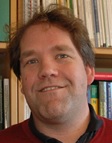Erik Öckinger

Presentation
I am interested in processes that maintain biodiversity, at multiple spatial scales. My research spans from basic to applied aspects of ecology. I study the consequences of land use and climate change on populations and communities, and strategies to preserve, restore and monitor biodiversity in human-dominated landscapes.
I have a special interest in biodiversity in grasslands, but my reserach includes both agricultural, forest and urban landscapes and habitats. In much of my research I focus on pollinating insects, and I have a special interest in butterflies. I also do research on plant communities and plant-pollinator interactions, and conduct research syntheses including a wide range of organisms.
Research team and close collaborators
Dr. Elin Lundquist - postdoc
Svenja Horstmann - PhD
Dr. Malin Tälle - researcher
Dr. Juliana Dániel Ferreira - researcher at the Swedish Biodiversity Centre (CBM)
Opportunities for students and researchers
BSc and MSc students: I am happy to supervise BSc and MSc thesis projects related to my research interests. Please contact me to discuss potential topics.
PhD candidates: These positions are typically fully funded from the university, and are posted at the SLU website
Postdocs: I am willing to host new postdoctoral researchers who share my research interests and wish to apply for their own funding. Please contact me if you are interested in working on an application together.
Teaching
I am leading the course Tillämpad Naturvårdsbiologi (Applied Conservation biology).
I also teach in several other courses in ecology, conservation biology and field botany, and supervise several BSc and MSc projects each year.
Research
My current research interests include:
Conservation and restoration of biodiversity and ecosystem services in agricultural landscapes
I study how local management and restoration influence biodiversity and related ecosystem services in agricultural landscapes. In particular, I have long experience of studying biodiversity in species-rich semi-natural grasslands.
How novel habitats contribute to landscape-scale biodiversity
Novel habitats, such as road verges and power line corridors cover vast areas. Since these habitats often resemble traditionally managed grasslands, they might provide great opportunities for biodiversity conservation. I study how such habitats contribute to the biodiversity at the landscape scale, and how they can be managed to promote biodiversity and populations of pollinating insects.
Landscape strategies to promote biodiversity in the face of climate change
Climate change is changing biodiversity and species distributions directly, but also indirectly through altered agricultural and forest land use in response to climate change. Strategies for biodiversity conservation must account for this. I use field experiments, repeated historical surveys and data from systematic biodiversity monitoring programmes to study how land use and climate change impact populations, communities and species distributions.
Environmental analysis
I was part of a team at SLU that developed a proposal for a national monitoring programme for pollinating insects in the agricultural landscape, and has been engaged as an expert in the developments of a European pollinator monitorisng scheme.
Cooperation
I hold an assigment as external collaboration specialist in the field of Biodiversity. This means that I am responsible for outreach and collaboration with different actors in society.
Much of my research is directly relevant for authorities responsible for biodiversity conservation and for land owners and land managers. I frequently interact and cooperate with stakeholders such as public authorities, land owners and NGOs.
I also conduct research in direct collaboration with stakeholders. For example, I do field experiments on biodiversity-friendly habitat management of power-line clearings in collaboration with Svenska Kraftnät and of road verges in collaboration with Swedish Transport Administration.
Supervision
Previous members of the research team
Juliana Dániel Ferreira - PhD candidate 2017-2021
Marie Winsa - PhD candidate 2010-2016
Andy Ruck - postdoc 2021-2023
Jonas Josefsson - postdoc 2018-2021, now environmental consultant
Norbertas Noreika - postdoc 2018-2019, now at Estonian University of Life Sciences.
Giovanni Tamburini - postdoc 2017-2019, now researcher at University of Bari, Italy.
Yoan Fourcade - postdoc 2015-2019, now assistant professor at Paris-Est Créteil Val-de-Marne University, France.
Roser Rotchés‐Ribalta - visiting postdoc 2017.
Selected publications
For a complete list of publications, see my Google Scholar profile.
Some representative publications:
Horstmann, S., Herbertsson, L., Klatt, B.K., Auffret, A.G., Öckinger, E. 2025. Flower-rich road verges increase abundance of flower visitors in the surrounding landscape. Basic and Applied Ecology, 82: 59-65. https://doi.org/10.1016/j.baae.2024.12.004.
Dániel-Ferreira, J., Fourcade, Y., Bommarco, R., Wissman, J., Öckinger. E. 2023. Communities in infrastructure habitats are species-rich but only partly support species associated with semi-natural grasslands. Journal of Applied Ecology 60: 837-848. https://doi.org/10.1111/1365-2664.14378
Josefsson, J., Widenfalk, L.A., Blicharska, M., Hedblom, M., Pärt, T., Ranius, T., Öckinger, E. 2021. Compensating for lost nature values through biodiversity offsetting – where is the evidence? Biological Conservation 257: 109117. https://doi.org/10.1016/j.biocon.2021.109117
Fourcade, Y., WallisDeVries, M.F., Kuussaari, M., van Swaay, C.A.M., Heliölä, J., Öckinger, E. 2021. Habitat amount and distribution modify community dynamics under climate change. Ecology Letters 24: 950–957. http://doi.org/10.1111/ele.13691.
Gardiner, M.G., Riley, C.B., Bommarco, R., Öckinger E. 2018. Rights-of-way – a poorly exploited conservation resource with potential. Frontiers in Ecology and the Environment 16: 149-158.
Öckinger, E., Winsa, M., Roberts, S.P.M., Bommarco, R. 2018. Mobility and resource use influence the occurrence of pollinating insects in restored semi-natural grassland fragments. Restoration Ecology 26: 873-881.
Fourcade, Y., Ranius, T., Öckinger, E. 2017. Temperature drives abundance fluctuations, but spatial dynamics is constrained by landscape configuration: implications for climate-driven range shift in a butterfly. Journal of Animal Ecology 86: 1339–1351.
Öckinger, E., Schweiger, O., Crist, T.O. Debinski, D.M., Krauss, J., Kuussaari, M., Petersen, J.D., Pöyry, J., Settele, J., Summerville, K.S. & Bommarco, R. 2010. Life-history traits predict species responses to habitat area and isolation – A cross-continental synthesis. Ecology Letters 13: 969-979.